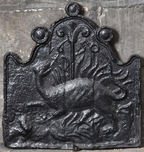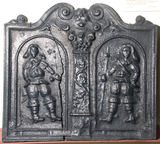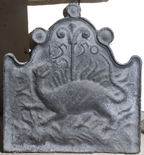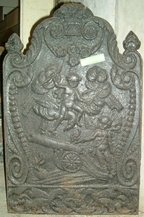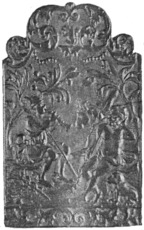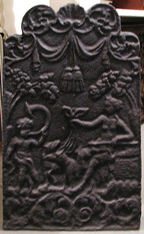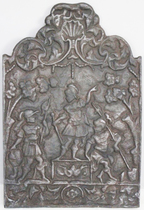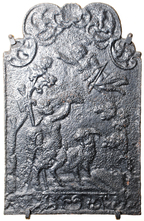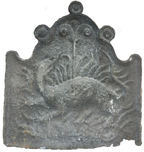-
354
Description: Quasi-arched rectangular shaped; unique, cavetto moulded edging, which loops upon itself three times. A mythical salamander shown in the flames which legend states it is able to resist; behind is what appears to be a palm tree, on either side of which the date is stamped. Two plank-lines.
Notes: Whole pattern with added date; one of a series of firebacks where the number ‘1’ is hooked at both ends. Damage and subsequent repair to the bottom right corner has obliterated a letter 'M' seen on another casting; presumably part of 'IM'. A variant, at Lewes, is incorrectly dated 1550.
Copies of this fireback are known.
Inscription: 1650
- Decoration tags:
- rectangular with ornate arch (shape)
- cavetto (edging)
- whole carved pattern
- individual numbers
- planklines
- pictorial
- mythological
- text
- animals
Manufactured: in 1650 possibly at Brede Furnace in the Weald area of England.
Current location: East Riddlesden Hall, Keighley, Yorkshire, England.
Museum number: NT/ERH/M/40 (part of the National Trust museum group)
Citation: Schubert, H. R., 1957, 'A Forgery in Iron', Journal of the Iron & Steel Institute, 165, p. 125.
- Attached to series:
- Hooked '1' series
- Loop edged firebacks
- Brede group
-
400
Description: Rectangular with two mirrored scrolls on top, a lion’s face between; ogee-moulded edging; central pilaster with vine scrolling, Corinthian capital, a diamond on the pedestal; on either side, an arched alcove with fillet edging, each with a halberdier in mid-17th century clothes, their feet pointing to the middle.
Notes: A more common version (no. 81) has different edging and the pattern-maker’s initials. Formerly part of the J. H. Every collection.
- Decoration tags:
- rectangular with ornate arch (shape)
- cyma reversa/ogee (edging)
- whole carved pattern
- pictorial
- architectural
- humans
Manufactured: in the mid-17th century possibly at Brede Furnace in the Weald area of England.
Current location: Anne of Cleves House, Southover High Street, Lewes, East Sussex, England.
Museum number: 1944.24.064 (part of the Sussex Archaeological Society museum group)
- Attached to series:
- Brede group
-
407
Description: Quasi-arched rectangular shaped; unique, cavetto moulded edging, which loops upon itself three times. A mythical salamander shown in the flames which legend states it is able to resist; behind is what appears to be a palm tree, on either side of which the date is stamped.
Notes: The fireback has been incorrectly dated 1550 instead of 1650, which Schubert, following W. R. Lethaby, asserted was a forgery claiming indications that a ‘6’ had been erased. Undoubtedly the first '5' is more prominent than the other figures though the exact method by which it has been substituted is not clear. Corrosion to the bottom right corner may have obliterated a letter 'M' seen on another casting; presumably part of 'IM'.
Inscription: 1550
- Decoration tags:
- rectangular with ornate arch (shape)
- cavetto (edging)
- whole carved pattern
- individual numbers
- pictorial
- mythological
- text
- animals
Manufactured: in 1650 possibly at Brede Furnace in the Weald area of England.
Current location: Anne of Cleves House, Southover High Street, Lewes, East Sussex, England.
Museum number: LH000.901 (part of the Sussex Archaeological Society museum group)
Citation: Dawson, C., 1903, 'Sussex Iron Work and Pottery', Sussex Archaeological Collections, 46, pp. 1-54.
Citation: Gardner, J. S., 1898, 'Iron Casting in the Weald', Archaeologia, 56, 1, pp. 133-164.
Citation: Lethaby, W. R., 1 Oct 1926, 'English Cast Iron - I', The Builder, 131, no. 4365, pp. 537-8.
Citation: Schubert, H. R., 1957, 'A Forgery in Iron', Journal of the Iron & Steel Institute, 165, p. 125.
- Attached to series:
- Hooked '1' series
- Loop edged firebacks
- Brede group
-
478
Description: Quasi-arched rectangular shape; fillett edging; vertical stylised seed pods contra-scrolled at each end, flanking central pictorial scene of young Jupiter in front of clouds and sunbeams, above young Mars firing a cannon; above, three roses suspended from swirls flanking a basket of flowers; on each side a foliate scroll with a flower bud resting on each; at the bottom, a separate panel with symmetrical swirled foliage.
Notes: One of a small series of firebacks with similar borders.
- Decoration tags:
- rectangular with ornate arch (shape)
- fillet (edging)
- whole carved pattern
- pictorial
- mythological
- humans
- objects
Manufactured: in the early-18th century in England.
Current location: Maidstone Museum, St Faith's Street, Maidstone, Kent, England.
(part of the Maidstone Museum museum group)
- Attached to series:
- Late pictorial series (all)
- Late pictorial series 1
-
1290
Description: Rectangular, with arch at the top. Above and below acanthus vines. In the middle a landscape with trees and two seated figures; on the left Mercury, playing a flute, a staff over his right shoulder, and at his feet a caduceus; to the right a seated male figure with his left hand supporting his head, in his right hand a stick with which he is supporting himself, behind him a cow, at his feet a dog.
Notes: A scene from classical mythology.
- Decoration tags:
- rectangular with ornate arch (shape)
- fillet (edging)
- whole carved pattern
- pictorial
- mythological
- animals
- humans
- plants
- objects
Manufactured: in the early-18th century in England.
Current location: Rotterdam, Netherlands.
Museum number: 15229 (part of the Museum Rotterdam museum group)
- Attached to series:
- Late pictorial series 2
- Late pictorial series (all)
-
866
Description: Rectangular with a sinuous arch and three simulated loops, one top centre, the other two to each side; two-handled flower vase with gadrooned upper surface and acanthus bas-relief below, trailing fruited vines issuing from top descending through handles to base; lion’s mask at top; date split either side of vase base; ball on each shoulder of the plate; broadened side edges.
Notes: The simulated loops are seen on a small number of other firebacks, suggesting a common pattern-maker; a variation on a design typical of this period.
Inscription: 16 77
- Decoration tags:
- rectangular with ornate arch (shape)
- fillet (edging)
- whole carved pattern
- individual numbers
- extension panels
- pictorial
- text
- plants
- objects
Manufactured: in 1677 possibly in the Weald area of England.
Current location: Metropolitan Museum of Art, 1000, Fifth Avenue, New York, New York, United States of America.
Museum number: 08.81.1 (part of the Metropolitan Museum of Art, New York museum group)
- Attached to series:
- Gadrooned vase firebacks
- Loop edged firebacks
-
868
Description: Rectangular with arched, mirrored scrolls on top and central scallop shell, below which are swagged drapes with a central tassel; fillet edging; in a grove, to the left a putto blowing a horn, to the right a semi-naked female figure seated, holding the tail of a fish, with two ?dogs at her feet; at the bottom, narrow panel with symmetrical scrolled foliate decoration.
Notes: Like others in the series, the scene is not immediately identifiable with a scene in classical mythology.
Copies of this fireback are known.
- Decoration tags:
- rectangular with ornate arch (shape)
- fillet (edging)
- whole carved pattern
- pictorial
- mythological
- animals
- humans
- plants
Manufactured: in the early-18th century in England.
Current location: Metropolitan Museum of Art, 1000, Fifth Avenue, New York, New York, United States of America.
Museum number: 08.81.6 (part of the Metropolitan Museum of Art, New York museum group)
- Attached to series:
- Late pictorial series (all)
- Late pictorial series 2
-
211
Description: Rectangular with arched, mirrored, scrolls on top, a cartouche scallop shell between; fillet edging; between two trees, three soldiers in Roman dress, holding either pikes, swords or shields, one on a plinth; at the bottom, a separate rectangular panel with mirrored scrolled foliage.
Notes: Possibly intended to represent the Horatii who, according to Livy, defeated the Curiatii.
Copies of this fireback are known.
- Decoration tags:
- rectangular with ornate arch (shape)
- fillet (edging)
- whole carved pattern
- pictorial
- mythological
- humans
Manufactured: in the early-18th century in England.
Current location: Kernow Furniture, Penhalvean Pottery, Penhalvean, Cornwall, England.
- Attached to series:
- Late pictorial series (all)
- Late pictorial series 4
-
521
Description: Rectangular with arched, mirrored scrolls on top and central scallop shell; fillet edging; Pan, with a goat behind, trees to left and right; a putto above right; at the bottom, a separate rectangular panel with mirrored scrolled foliage.
Notes: A scene apparently unrelated to a specific classical narrative, and without the customary decorated border. Mitford collection, Petworth House.
Copies of this fireback are known.
- Decoration tags:
- rectangular with ornate arch (shape)
- fillet (edging)
- whole carved pattern
- pictorial
- mythological
- animals
- humans
- plants
Manufactured: in the early-18th century in England.
Current location: Petworth House, Petworth, West Sussex, England.
Museum number: NT/PET/M/75 (part of the National Trust museum group)
- Attached to series:
- Late pictorial series (all)
- Late pictorial series 2
-
891
Description: Quasi-arched rectangular shaped; unique, cavetto-moulded edging, which loops upon itself three times. A mythical salamander shown in the flames which legend states it is able to resist; behind is what appears to be a palm tree.
Notes: Other known variants are dated; this variant confirms that the dates were added to subsequent castings. Corrosion to the bottom right corner may have obliterated a letter 'M' seen on another casting; presumably part of 'IM'.
- Decoration tags:
- rectangular with ornate arch (shape)
- cavetto (edging)
- whole carved pattern
- pictorial
- mythological
- animals
Manufactured: in the mid-17th century possibly at Brede Furnace in the Weald area of England.
Current location: not known.
Citation: Schubert, H. R., 1957, 'A Forgery in Iron', Journal of the Iron & Steel Institute, 165, p. 125.
- Attached to series:
- Hooked '1' series
- Loop edged firebacks
- Brede group
